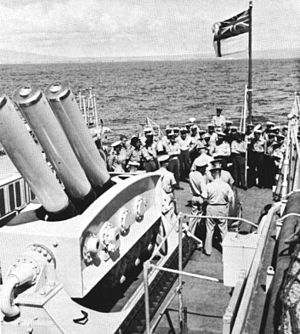Limbo (weapon)
This article includes a list of references, related reading, or external links, but its sources remain unclear because it lacks inline citations. (April 2011) |
| Limbo | |
|---|---|
 A Limbo mortar on HMNZS Taranaki (F148) | |
| Type | Anti-submarine mortar |
| Place of origin | United Kingdom |
| Service history | |
| In service | 1955–1980s |
| Used by | Royal Navy Royal Australian Navy Royal Canadian Navy Libyan Navy |
| Wars | Falklands War |
| Production history | |
| Designer | Admiralty Underwater Weapons Establishment |
| Specifications | |
| Crew | 3 |
| Shell | 400lb depth charge |
| Calibre | 12 inches (30 cm) |
| Barrels | 3 |
| Effective firing range | 400 yards (366 m) to 1,000 yards (914 m) |
| Warhead | Minol |
| Warhead weight | 94 kilograms (207 lb) |
Detonation mechanism | Proximity and/or Time |
Guidance system | Type 170 sonar |
Limbo, or Anti Submarine Mortar Mark 10 (A/S Mk.10), was the final British development of a forward-throwing anti-submarine weapon originally designed during the Second World War. Limbo, a three-barreled mortar similar to the earlier Hedgehog and Squid which it superseded, was developed by the Admiralty Underwater Weapons Establishment in the 1950s. Squid was loaded manually, which was difficult on a pitching deck in heavy seas with no protection from the elements; in contrast Limbo was loaded and fired automatically, with all the crew under cover. It was widely fitted on the quarterdeck of Royal Navy escort ships on a mounting stabilised for pitch and roll from 1955 to the mid–1980s. Australian built versions of the Template:Sclass- destroyer all carried Limbo as did the Australian Template:Sclass2-. Limbo was also widely employed by the Royal Canadian Navy, being incorporated into all destroyer designs from the late 1950s to the early 1970s, including the Template:Sclass-, Template:Sclass-, Template:Sclass-, Template:Sclass- and Template:Sclass- classes.
The firing distance of the mortars was controlled by opening gas vents; rounds could be fired from 400–1,000 yards (370–910 m). The weapon was linked to the sonar system of the ship, firing on command when the target was in range. The rounds were projected so that they fell in a triangular pattern around the target. Limbo could fire in any direction around the ship and is reported[by whom?] to have been very accurate. The weapon was used in the 1982 Falklands War, and remained in service in the Royal Navy and Commonwealth navies until the 1990s. A surviving system is preserved at Explosion! Museum of Naval Firepower in Gosport, Hampshire.
Sonar control of the A/S Mortar Mk 10
The firing of the Mortar Mk 10 was controlled by the Type 170 (and later the 502) attack sonar from the Sonar Control Room (SCR), which was generally located next to the operations room in the warship.
The 170 sonar had 3 operators who maintained sonar contact with the target and effectively aimed the weapon in bearing, range and depth. The operators were controlled by the SCO (Sonar Control Officer) who was in charge of the SCR.
When a contact had been confirmed as a hostile submarine, the SCO manually fired the Mortar Mk 10 from the SCR upon receiving the order from the captain in the operations room. The firing was done by means of a pistol grip and trigger mounted to the deckhead immediately behind the operators.
General characteristics
- Total system weight: 35 tons including 51 projectiles (17 salvos).
References
- Naval Armament, Doug Richardson, 1981, Jane's Publishing, ISBN 0-531-03738-X
